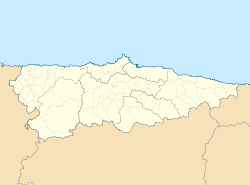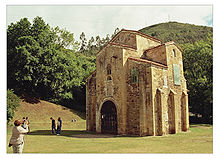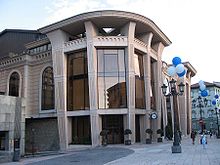- Oviedo
-
For other uses, see Oviedo (disambiguation).
Oviedo
Uviéu (Asturian)— Municipality — 
Flag
Coat of armsMotto: Benemérita, invicta, heroica, buena, muy noble, muy leal
(Meritorious, undefeated, heroic, good, very noble, very loyal)Location in Asturias Location in Spain Coordinates: 43°21′36″N 5°50′42″W / 43.36°N 5.845°WCoordinates: 43°21′36″N 5°50′42″W / 43.36°N 5.845°W Country  Spain
SpainAutonomous community Principado de Asturias Province Asturias Comarca Oviedo Capital Oviedo Government – Alcalde Gabino de Lorenzo (PP) Area – Total 18.665 km2 (7.2 sq mi) Elevation 232 m (761 ft) Population (2009) – Total 224,005 – Density 12,001.3/km2 (31,083.3/sq mi) Demonym ovetense or carbayón Time zone CET (UTC+1) – Summer (DST) CEST (UTC+2) Postal code 33001 and 33013 Official language(s) Castilian Website Official website Oviedo (Asturian: Uviéu; Spanish pronunciation: [oˈβjeðo], asturian pronunciation: [uˈβjeu̯]) is the capital city of the Principality of Asturias in northern Spain. It is also the name of the municipality that contains the city.
Oviedo, which is the administrative and commercial centre of the region, also hosts the annual Prince of Asturias Awards. This prestigious event, held in the city's Campoamor Theatre, recognizes international achievement in eight categories. Award winners in 2007 include Bob Dylan in the category of Arts and Al Gore in the category of International Cooperation. Oviedo University's international campus attracts many foreign scholars from all over the globe.
Contents
History
It is said that two monks, Máximo and Fromestanus, founded the city in 761. That settlement was soon to be completed with the construction of a small church dedicated to Saint Vincent. Nevertheless, the archaeological register has shown traces of occupation since the 1st century, in Roman times.
King Fruela I of Asturias, the fourth of the Asturian monarchs, was the first decided promoter of the city as may be witnessed by his construction of both a palace and a nearby church. Oviedo owes to a later king, Alfonso II The Chaste (791-842), its establishment as a capital city and ruling seat as a result of the moving of the court from Pravia and the creation of the Pilgrim’s Route to Santiago de Compostela, a major event in the history of Oviedo, a church dedicated to The Saviour, the Cathedral of San Salvador, and a royal palace formed the nucleus and motive power of Oviedo.
During this period the city became the centre of an original and unique architectural expression, inheritor of Visigothic, Roman and Nordic traditions, which was to reach its high point during the reign of Ramiro I of Asturias. Ramiro I sponsored many unique construction projects, which remain a signature of Oviedo to this day.
The moving of the royal court to León, after the death of Alfonso III, The Great, links the life of the city to the relics preserved in its cathedral and the passing of pilgrims that visit El Salvador, and continue on their way to Santiago de Compostela. The following centuries (12th-16th) witness the development of the medieval city, the outlines of which are still preserved today, the construction of the city walls, a devastating fire which took place on Christmas Eve in 1521, and the aqueduct works, Los Pilares, constructed in order to provide the city with water throughout the 16th century.
The foundation of the Arts College (University of Oviedo) by Fernando de Valdés Salas, at the beginning of the 17th century, opened Oviedo to a progressive urban expansion. Further impulse was in the 18th century by the regional nobility and the construction of remarkable palaces; in the 19th century by industrial growth and the suburban development of Uría Street; and finally in the 20th century by administrative and commercial development.
The Siege of Oviedo in 1936 was a memorable event in the Spanish Civil War. The army garrison rose in support of the coup d'état and stood a siege of three months by an improvised force, loyal to the Republican government until relieved in 1937.
Architecture
- Cathedral of San Salvador, from 13th century, erected in 1288 over the previous cathedral, which was founded in the 8th century.
- Cámara Santa de Oviedo. Dating from 802. It is located within the Cathedral, and it is a UNESCO World Heritage Site.
- Santa María del Naranco Hall, 9th century. A relatively large pavilion, part of the palace complex built for and by King Ramiro I.
- San Miguel de Lillo (small church), 9th century.
- Basilica of San Julián de los Prados.
- La Foncalada. Fountain of the 9th century. It is the only preserved Pre-Romanesque civil work in the whole of Europe.
- The University of Oviedo was created in 1574, but only inaugurated on September 21, 1608, the feast of Saint Matthew. It was funded by the terms of the will of Archbishop D. Fernando Valdés Salas, minister and General Inquisitor under Charles V, Holy Roman Emperor and Philip II.
- Town Hall (Casa Consistorial). Dates from 1662.
- La Balesquida Chapel (13th century). Associated with Oviedo's taylors' guild. Repeatedly restored in the 17th, 19th and 20th centuries. It is dedicated to the Virgin of Hope.
- House of the Llanes (18th century). It is the best Baroque façade in the whole of Asturias.
- Deán Payarinos' House (20th century). A building on the Beaux Arts style. Nowadays, it houses the Eduardo Martínez Torner Conservatory.
- The Monastery of San Vicente (8th century). At the moment, home of the Archaeological Museum of Asturias.
- The Convent Church of Santo Domingo, Oviedo (16th century). One of the monastic settlements outside the city walls. The original building burnt down in 1934 and it was heavily reconstructed after the Civil War.
- El Fontán Market (17th-18th centuries). A simple but rather monumental complex; an 18th century porticoed square, which housed the vegetable market. It fell victim to speculative manoeuvres. It was left to deteriorate on its own; claiming that it was beyond repair, it was then demolished on 1998 and rebuilt offering all modern amenities, but with its original proportions radically changed; the original complex being much lower than its modern replacement.
- Casas del Cuito, early 20th century Art Nouveau apartment building
Culture
Oviedo inspired the fictional city of Vetusta in Leopoldo Alas' La Regenta. Other Spanish writers were inspired by the city, including Ramón Pérez de Ayala in Tigre Juan and Dolores Medio in her novel Nosotros los Rivero.
Oviedo was featured prominently in Woody Allen's movie Vicky Cristina Barcelona.
Museums in Oviedo:
- Archaeological Museum of Asturias
- Fine Arts Museum of Asturias
- Camara Santa within the Cathedral
- Diocesan Museum
- Tabularium Artis Asturiensis
- Center for the reception and understanding of Preromanesque Art
- (future) Museum of the Militar Technology and Industry
Other cultural centres in Oviedo:
- Campoamor Theatre
- Filarmónica Theatre
- Prince Felipe Auditorium
- Princess Letizia Congress Palace (in construction)
Sports
Teams based in Oviedo
- Real Oviedo, football team. (Segunda División B league)
- Esfer Oviedo, roller hockey team. (OK Liga, first division)
- Domo Residencial Oviedo, basketball team. (EBA league, group A)
Annual sports events
- International Showjumping Competition
- City of Oviedo Horse Show
- City of Oviedo San Silvestre
- City of Oviedo Trial Indoor
- Outdoor Sports Climbing
- Vuelta a España (Cycling)
- Tour of Asturias (Cycling)
- Ascent of Naranco (Cycling)
- City of Oviedo Mountain Bike Open
- City of Oviedo Cycle Criterium
- Base Hockey International Tournament
- International Icehockey Tournament
- Prince of Asturias International Rally
- National Auto-Cross Championship
- International Hurdles Competition
- International Chess Open
- Boxing Nights
- City of Oviedo Weightlifting Championship
- Ascension Bowls Tournament
- San Mateo Bowls Tournament
Feasts and traditions
The Festive Calendar:
- Cabalgata de los Reyes Magos de Oriente: The traditional Twelve Night parade, where the Three Wise Men of the East and their retinue parade through the city main streets, reaching the Cathedral Square, where they make their offering to the Child Jesus.
- L'Antroxu (Carnival)
- Feast of the Ascension
- La Foguera de San Xuan (Saint John's Bonfire):
- La Balesquida or Martes del Bollu:
- The Feast of San Mateo
- El Desarme (Disarmament's Day), commemorating the cunning victory of the locals over a Carlist army during the First Carlist War, during the 1830s
Gastronomy:
- Fabada, bean stew with selected cuts of pork, etc.
- Callos, tripe
- Carne gobernada, (chunks of meat, prepared with onion, garlic and white wine sauce)
- Chorizo a la sidra, (chorizo sausage prepared in cider)
- Paxarines
- Carbayones, Oviedo's typical almond pastry
- Sidra, (cider), Asturian typical drink, fermented apple cider
- Arroz con leche, similar to milk pudding
- Frixuelos, similar to crepes
Climate
Climate data for Oviedo Month Jan Feb Mar Apr May Jun Jul Aug Sep Oct Nov Dec Year Average high °C (°F) 11.7
(53.1)12.8
(55.0)14.4
(57.9)14.9
(58.8)17.6
(63.7)20.3
(68.5)22.4
(72.3)22.8
(73.0)21.7
(71.1)18.1
(64.6)14.6
(58.3)12.5
(54.5)17.0 Daily mean °C (°F) 8.0
(46.4)8.8
(47.8)10.0
(50.0)10.6
(51.1)13.3
(55.9)16.1
(61.0)18.3
(64.9)18.7
(65.7)17.3
(63.1)14.0
(57.2)10.8
(51.4)9.0
(48.2)12.9 Average low °C (°F) 4.2
(39.6)4.8
(40.6)5.6
(42.1)6.3
(43.3)9.1
(48.4)11.9
(53.4)14.1
(57.4)14.5
(58.1)12.9
(55.2)10.0
(50.0)7.1
(44.8)5.5
(41.9)8.8 Precipitation mm (inches) 85
(3.35)85
(3.35)82
(3.23)109
(4.29)94
(3.7)53
(2.09)52
(2.05)55
(2.17)64
(2.52)98
(3.86)101
(3.98)96
(3.78)973
(38.31)Avg. precipitation days (≥ 1 mm) 10 11 11 13 12 8 8 8 8 11 11 11 122 Sunshine hours 117 117 147 152 158 168 174 171 154 134 114 105 1,711 Source: Agencia Estatal de Meteorología[1] Notable people
- Emilio Alarcos Llorach, linguist
- Leopoldo Alas Clarín, 19th century novelist and literary critic
- Fernando Alonso, Formula One driver and a two-time world champion
- Antonio Gamoneda winner of the 2006 Cervantes Prize
- Ángel González, poet
- Melendi, popular singer
- HRH Letizia Princesa de Asturias the consort of the Spanish Crown Prince
- Ramón Pérez de Ayala, writer
- Carmen Polo, wife of Spain's dictator Francisco Franco
- Indalecio Prieto, socialist politician. One the leaders of the Spanish Socialist Workers' Party up to the end of the Civil War and the posterior exile
- Samuel Sánchez, cyclist. 2008 Olympic Road Race Champion.
- Tioda, 9th century architect who designed several of the city pre-romanesque buildings.
Other places in the municipality
- Trubia
- Colloto (divided between two municipalities: Oviedo and Siero)
- San Claudio
- San Esteban de les Cruces
- Latores
- Olloniego
International relations
Twin towns — sister cities
Oviedo is twinned with:
 Valparaíso, Chile, since 1976
Valparaíso, Chile, since 1976 Bochum, Germany, since 1979
Bochum, Germany, since 1979 Buenos Aires, Argentina, since 1983
Buenos Aires, Argentina, since 1983 Veracruz, Mexico, since 1983
Veracruz, Mexico, since 1983 Clermont-Ferrand, France, since 1988
Clermont-Ferrand, France, since 1988 Tampa, Florida, United States, since 1991
Tampa, Florida, United States, since 1991 Santiago de Compostela, Spain, since 1993
Santiago de Compostela, Spain, since 1993 Santa Clara, Cuba, since 1995
Santa Clara, Cuba, since 1995 Jersey City, New Jersey, United States, since 1998
Jersey City, New Jersey, United States, since 1998 Zamora, Spain, since October 9, 2001
Zamora, Spain, since October 9, 2001 Torrevieja, Spain, since January 2, 2004
Torrevieja, Spain, since January 2, 2004 Hangzhou, China, since 2006
Hangzhou, China, since 2006 Valencia de Don Juan, Spain, since 2006
Valencia de Don Juan, Spain, since 2006 Oviedo, Florida, United States, since 2006
Oviedo, Florida, United States, since 2006 Viseu, Portugal, since April 10, 2007
Viseu, Portugal, since April 10, 2007 Maranello, Italy, since April 28, 2010
Maranello, Italy, since April 28, 2010
References
External links
- (English) Asturias Cities
- (Spanish) Municipality of Oviedo
- (English) Municipality of Oviedo and touristic informations
- (Spanish) University of Oviedo
- (English) Spanish Pre-Romanesque Art Guide; San Julian de los Prados.
- (English) Spanish Pre-Romanesque Art Guide; Santa María del Naranco.
- (English) Spanish Pre-Romanesque Art Guide; San Miguel de Lillo.
World Heritage Sites in Spain For official site names, see each article or the List of World Heritage Sites in Spain.North West Caves of Altamira and Paleolithic Cave Art of Northern Spain1 · Monuments of Oviedo and the Kingdom of the Asturias · Roman Walls of Lugo · Route of Santiago de Compostela1 · Santiago de Compostela · Tower of Hercules
North East Caves of Altamira and Paleolithic Cave Art of Northern Spain1 · Mudéjar Architecture of Aragon · Pyrénées - Mont Perdu2 · Rock-Art of the Mediterranean Basin on the Iberian Peninsula1 · Route of Santiago de Compostela1 · San Millán Yuso and Suso Monasteries · Vizcaya Bridge
Community of Madrid Aranjuez Cultural Landscape · El Escorial · University and Historic Precinct of Alcalá de Henares
Centre Archaeological Ensemble of Mérida · Archaeological Site of Atapuerca · Ávila with its Extra-mural Churches · Burgos Cathedral · Cáceres · Cuenca · Las Médulas · Rock-Art of the Mediterranean Basin on the Iberian Peninsula1 · Route of Santiago de Compostela1 · Salamanca · Santa María de Guadalupe · Segovia and its Aqueduct · Toledo · Prehistoric Rock-Art Sites in the Côa Valley and Siega Verde
East Archaeological Ensemble of Tarraco, Tarragona · Catalan Romanesque Churches of the Vall de Boí · Ibiza (Biodiversity and Culture) · Palau de la Música Catalana and Hospital de Sant Pau, Barcelona · Palmeral of Elche · Poblet Monastery · Rock-Art of the Mediterranean Basin on the Iberian Peninsula1 · Silk Exchange in Valencia · Works of Antoni Gaudí
South Alhambra, Generalife and Albayzín, Granada · Cathedral, Alcázar and Archivo de Indias, Seville · Córdoba · Doñana · Renaissance Monuments of Úbeda and Baeza · Rock-Art of the Mediterranean Basin on the Iberian Peninsula1
Canary Islands 1 Shared with other region/s · 2 Shared with FranceMunicipalities in Asturias Allande · Aller · Amieva · Avilés · Belmonte de Miranda · Bimenes · Boal · Cabrales · Cabranes · Candamo · Cangas de Onís · Cangas del Narcea · Caravia · Carreño · Caso · Castrillón · Castropol · Coaña · Colunga · Corvera de Asturias · Cudillero · Degaña · El Franco · Gijón/Xixón · Gozón · Grado · Grandas de Salime · Ibias · Illano · Illas · Llangréu/Langreo · Laviana · Lena · Llanera · Llanes · Mieres · Morcín · Muros de Nalón · Nava · Navia · Noreña · Onís · Oviedo · Parres · Peñamellera Alta · Peñamellera Baja · Pesoz · Piloña · Ponga · Pravia · Proaza · Quirós · Las Regueras · Ribadedeva · Ribadesella · La Ribera/Ribera de Arriba · Riosa · Salas · San Martín de Oscos · San Martín del Rey Aurelio · San Tirso de Abres · Santa Eulalia de Oscos · Santo Adriano · Sariego · Siero · Sobrescobio · Somiedo · Soto del Barco · Tapia de Casariego · Taramundi · Teverga · Tineo · Valdés · Vegadeo · Villanueva de Oscos · Villaviciosa · Villayón · Yernes y Tameza
Capitals of provinces of Spain - A Coruña
- Albacete
- Alicante
- Almería
- Ávila
- Badajoz
- Barcelona
- Bilbao
- Burgos
- Cáceres
- Cádiz
- Castellón de la Plana
- Ciudad Real
- Córdoba
- Cuenca
- Donostia-San Sebastián
- Girona
- Granada
- Guadalajara
- Huelva
- Huesca
- Jaén
- Logroño
- Las Palmas de Gran Canaria
- León
- Lleida
- Lugo
- Madrid
- Málaga
- Murcia
- Ourense
- Oviedo
- Palencia
- Palma
- Pamplona
- Pontevedra
- Salamanca
- Santander
- Santa Cruz
- Segovia
- Seville
- Soria
- Tarragona
- Teruel
- Toledo
- Valencia
- Valladolid
- Vitoria-Gasteiz
- Zamora
- Zaragoza
 Seville (Andalusia) · Zaragoza (Aragon) · Oviedo (Principality of Asturias) · Palma (Balearic Islands) · Vitoria-Gasteiz (Basque Country) · Santa Cruz de Tenerife & Las Palmas de Gran Canaria (Canary Islands) ·
Seville (Andalusia) · Zaragoza (Aragon) · Oviedo (Principality of Asturias) · Palma (Balearic Islands) · Vitoria-Gasteiz (Basque Country) · Santa Cruz de Tenerife & Las Palmas de Gran Canaria (Canary Islands) ·
Santander (Cantabria) · No capital (Castile and León) · Toledo (Castile-La Mancha) · Barcelona (Catalonia) · Mérida (Extremadura) · Santiago de Compostela (Galicia) · Logroño (La Rioja) · Madrid (Community of Madrid) ·
Murcia (Region of Murcia) · Pamplona (Navarre) · Valencia (Valencian Community) · Ceuta1 · Melilla11 Autonomous cities.Categories:- 761 establishments
- Municipalities in Asturias
- Oviedo
- Populated places established in the 8th century
- World Heritage Sites in Spain
- Populated places in Asturias
Wikimedia Foundation. 2010.



















